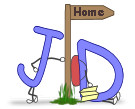
|
<<Back |
Turin, Italy
February 17-20,
2006 |
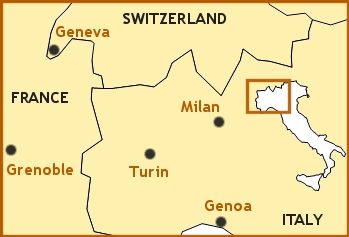
|
|
|
| D was wrapping up his temporary
assignment in France, and we couldn't pass up the opportunity
of making the short trip to Turin to attend our first
Winter Olympic Games. So without the tickets that were
supposed to be delivered but never were and a semi-confirmed
hotel room in the heart of Turin, we made our way across
the Alps (or through them
as the case may be) to spend a few days at the temporary
focal point of winter sports. |
|
|
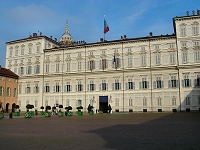
The royal palace.
|
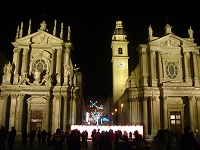
The twin churches in Piazza
San Carlo.
|
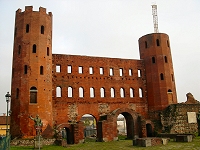
One of the entrances to the
Roman camp.
|
|
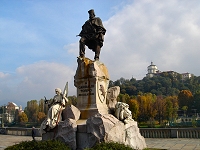
Garibaldi and Sant Maria del
Monte.
|
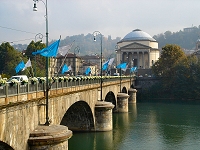
Gran Madre di Dio perched along
the Po.
|
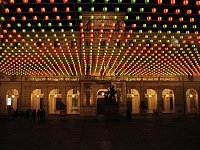
The Green Count in front of
the city hall.
|
|
|

The Mole Antonelliana dominates
the Turin skyline.
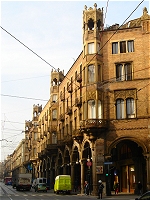
Splendid architecture and arcades
along Via Pietro Micca.
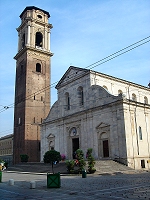
Duomo de San Giovanni Battista.
|
Over the years Turin grew from
a Roman outpost to the capital of Italy to a modern
industrial city. To protect the northern frontier
from the Gauls, Julius Caesar founded a military camp
in the Piemonte region of Italy. Named Castra Taurinorum
after the taurini or mountain people that inhabited
the area, it eventually grew to the city called Torino.
After the Romans, it was subjected to a number of
rulers including the Goths, Franks, Lombards, and
the Church until it finally ended up in the hands
of the House of Savoie whose territory included most
of the western Alps from north of Geneva to Nice.
In 1559, the Savoie dynasty moved its capital from
Chambéry on the French side of the Alps to
Turin bringing with them their most prized possession
of the Holy Shroud. The shroud or sindone is
currently kept in the Duomo de San Giovanni Battista
but won’t be on display again until 2025. Turin flourished
under Savoie rule which directed the construction
of Baroque palaces and churches as well as the nearly
11 miles of arcades found throughout the city center.
Through marriages, treaties, and land swaps, the House
of Savoie eventually became kings of a united Italy
under Vittorio Emanuele II in 1861, making Turin its
first capital before it was moved to Florence and
ultimately Rome.
Modern Turin became an Italian
industrial powerhouse with the 1899 founding of Fabbrica
Italiana Automobili Torino, more commonly known as
FIAT, Lancia in 1909, and Kappa clothing in 1916.
Turin was the birthplace of the Italian cinema industry
as well as media giants such as RAI telecommunications
and the La Stampa newspaper. A list of native sons
and daughters of Turin would include Amedeo Avogadro,
the Agnelli family (founders of FIAT and owners of
Juventus), Vincenzo Lancia, Alessandro Martini (famed
vermouth tycoon with partner Luigi Rossi), Umberto
Tozzi, and Carla Bruni.
Turin is also well known in
culinary circles as the birthplace of solid chocolate.
Prior to the 18th century, chocolate was limited to
the affluent society and still consumed as a drink.
It was the House of Savoie that introduced it to Turin
from their connections in Spain. In 1778, the first
machine to create a chocolate paste was developed
in Turin enabling chocolate to be consumed as a solid.
In the 19th century, the Napoleonic wars made cocoa
beans increasingly more expensive and difficult to
obtain. In Turin, easily obtainable hazelnuts were
ground and added to the paste resulting in the distinctive
gianduiotto chocolate for which Turin is now
renowned. A century, Pietro Ferrero created a spreadable
version in Turin, now known as Nutella. Another wonderful
Italian confectionary, nougat or torrone, is
also reported to have its origins in Turin where,
since pre-Roman times, the locals used to consume
a paste made from pine nuts and honey. Chocolate is
also a primary ingredient in the drink first made
popular at Turin’s oldest café, Al Bicerin.
|
|
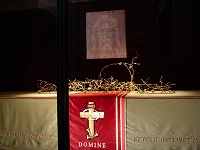
The case containing the Sacra
Sindone.
|
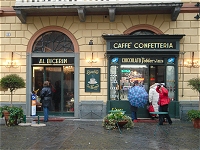
Al Bicerin first opened in 1763.
|
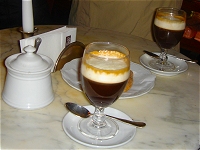
A Bicerin - chocolate, coffee,
and milk.
|
|
|
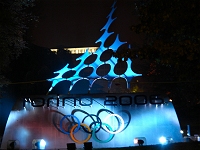
Host city of the XX Winter Olympiad.
|
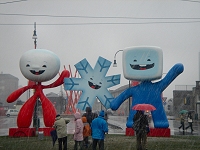
Y'all come back now.
|
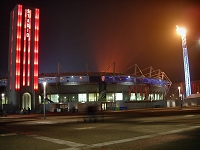
Stadio Olimpico.
|
|
|
Getting to Turin has always
been eventful for us. This time we found ourselves
waiting for a train at the Chambéry gare
when we should have been waiting for a bus across
the street. D had failed to notice that what he thought
were train tickets were actually bus tickets, a minor
point that the French rail ticket agent also neglected
to mention. Nevertheless, we arrived just in time
for Friday evening rush hour and to hustle down to
the Olympic Stadium to pick up our tickets that never
arrived in the mail. Tickets for one event safely
in hand, we looked at some options to supplement our
bounty – maybe ski jumping, speed skating, giant slalom,
or short-track? No, only women’s hockey and curling
were available. We decided to stick with what we had
and try again in the morning.
Turin had prepared well for
the occasion. The construction that permeated the
city in November when D had visited was all but gone.
Streets had been closed to cars in order to accommodate
the additional foot traffic generated. Plenty of extra
buses and trams were put into action to move spectators
to and from the Olympic venues in the southern part
of city. Stores extended their hours. Streets and
piazzas were decked out with lights to commemorate
the event. We joined the flow of tourists up the Via
Roma and into the Piazza San Carlo to take in the
Olympic atmosphere. The piazza was buzzing with visitors
displaying their colors – drunken Swedes singing,
drunken Russians singing louder, and Japanese taking
pictures of it all. As we moved on to take in Piazza
Reale, expecting even more festivities, we were disappointed
to see that it was completely surrounded by barricades.
Turin’s hub was being used to host the medal ceremonies
and some weekend concerts such as Paolo Conte, Whitney
Houston, and Anastasia. Consequently, the piazza had
been sealed off for security reasons. Passing through
security checkpoints would be an underlying theme
throughout our visit – an unfortunate sign of the
times.
One of the logistical drawbacks
of a Winter Olympics is that most of the events don’t
take place in the host city but rather in the surrounding
mountains. In the case of Turin, the mountain events
were a two-hour trip away, not to mention the 45 minutes
required to pass through security, making it challenging
to go to an Alpine event and then one in Turin on
the same day. In town, one could only choose from
hockey, speed skating (both varieties), and figure
skating or ice dancing – both of which have no place
in the Olympics anyway. One critical thing to know
if you decide to go to an Olympics is that it is all
about the pins. Pins can be used as currency, similar
to beads at Mardis Gras. People are either selling
them, trading them, or asking for them everywhere
you go. J had orders to bring home an Olympic lanyard
and when she tapped a member of the Japanese media
on the shoulder to inquire where he had gotten his,
he confusingly thrust a pin at her.
|
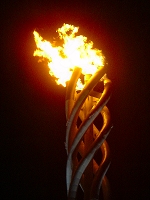
Turin's Olympic flame.
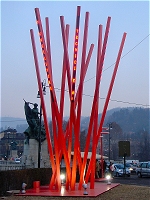
Scrolling orange sticks scattered
around town.
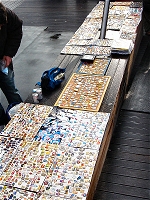
Pin peddlers.
|
|
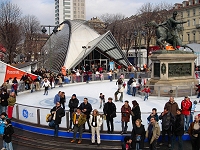
Inside the Sponsors' Village.
|
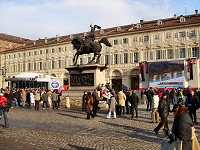
The big screen at Piazza San
Carlo.
|
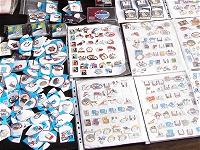
It's all about the pins.
|
|
|
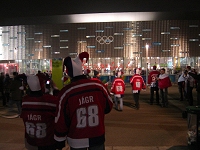
There were Jagrs everywhere.
|

Adversaries compare costumes.
|

Olympic self-portrait.
|
|
|
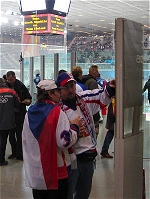
Looking for Category C seats.
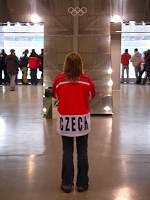
A prayer to the Olympic gods.
|
Having spent the day sightseeing
and absorbing the Olympic experience, it was finally
time to see an event. We were fortunate to have tickets
for the Group A hockey match-up between the defending
world champion Czech Republic and Finland who were
red-hot following 5-0 and 6-0 victories over Switzerland
and Italy respectively. An additional bonus was that
the game was held at the Palasport Olimpico within
the confines of the Olympic Stadium complex. The hockey
arena is as marvelous from the outside as it is from
the inside – bright, shiny, and brand new – with vertical
seating to give excellent views of the action. We
were somewhat disheartened to see that our more €40
Category B tickets meant we had to watch from the
rafters and through the netting hung to protect us
from errant pucks. We never figured out where Category
C seats were located.
The atmosphere was charged
with Czech fans draped in flags and Jagr and Hasek
jerseys. Finn fans were clearly outnumbered about
4 to 1 but shouted Suomi chants and wielded inflatable
blue and white hammers to make up for it. The game
itself was fast-paced with few stoppages, superior
to most NHL games we’ve attended. The Czechs, who
were among the favorites to win gold in Turin, had
already lost Dominic Hasek to a leg injury and then
lost Jaromir Jagr in the second period when Jarkko
Ruutu slammed him into the boards. Jagr lay on the
ice bleeding for five minutes while the referees peeled
off Czech players that had piled onto Ruutu. In the
end, the Finns were too much for the Czechs and extended
their unbeaten streak with a 4-2 victory.
|
|
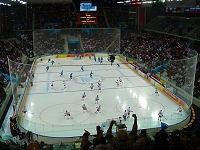
Inside the new Palasport Olimpico.
|
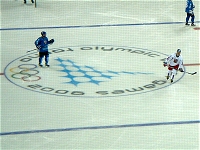
Selanne and Jagr warm up.
|

Jagr stains the ice.
|
|
|
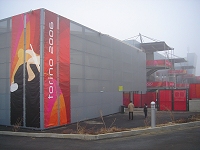
The curling venue in Pinerolo.
|
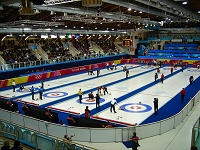
Eight teams on four sheets.
|
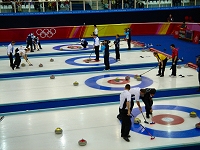
There was action everywhere.
|
|
|
Our train back to France did
not depart until evening, giving us the better part
of a day to satiate our appetite for Olympic action.
There was only one thing to do – go see some curling.
The curling competition was early in the morning and
scheduled for Pinerolo, about 30 miles from Turin,
so we had to take the train. As it was an impulsive
decision, we had no tickets and were therefore in
the unusual situation of being in need of a curling
scalper. Our prayers were answered when we spotted
a shady-looking Scottish bloke who was looking to
offload some tickets. The deal done, we got in line
for the security checkpoint, looking around to make
sure we hadn’t been observed by the carabinieri.
We were closely inspecting our tickets for authenticity,
when the gentleman in front of us asked if we were
big curling fans. We admitted our ignorance and asked
for any insight he could offer. It turns out that
not only was our line mate from Bemidji, Minnesota
– the curling capital of the US – but he was also
the father of Joe Polo, a member of the US team. In
fact, half of the men’s and women’s US team members
hail from Bemidji.
Once safely inside, we took
our seats as the teams took the ice. We had watched
some curling before and were familiar with the gist
of the game, but we were both very impressed with
the amount of action going on among the four sheets
(curling terminology) being used. In fact it was hard
to follow one game without being distracted by another.
The Italian fans were going crazy at every throw from
the home team. The USA was poised to enter the medal
round with a win but had the unenviable match-up with
Great Britain whose team was stacked with Scots, inventors
of the game. The young Bemidjians took an early lead
and never looked back. All of the games we witnessed
that morning went down to the wire. The Germans edged
the Swedes while the Finns finally silenced the Italian
crowd to notch a win and a share of first place. Even
the Norwegians had to fend off a tenacious effort
from New Zealand but sent the hapless Kiwis to an
eighth consecutive loss.
|
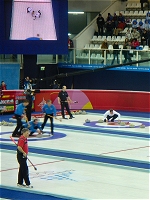
Overhead views on the big screen
help fans follow play.
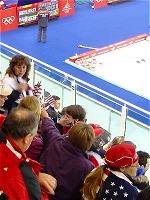
Rowdy American fans celebrate
a win over the dreaded Scots.
|
|
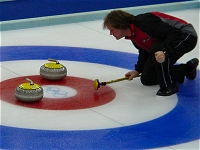
A game of inches.
|
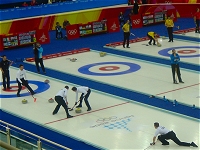
The US boys sweep to victory.
|
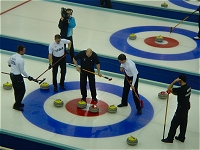
Intense strategy.
|
|
Copyright © 2005 JnDsTravelog.com. All rights reserved. |
| |